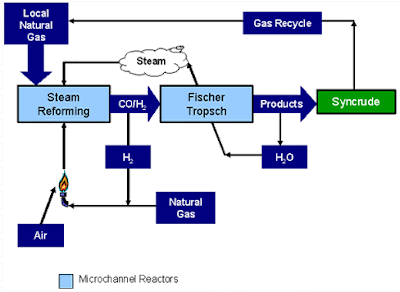Award Winning Microchannel Fischer Tropsch BTL and GTL
A British and Portuguese biomass to liquids (BTL) demonstration plant located in Austria and using US technology, plans to gasify woodchips to syngas, then convert the syngas to liquid fuels inside a micro-channel Fischer-Tropsch reactor. As illustrated above, the same technology can turn natural gas into liquid fuels.
The microchannel FT reactors discussed above recently won an "XTL" award at the 10th annual XTL summit in London.
The small size of these GTL and BTL microchannel reactors should allow for even greater decentralisation in the production of liquid fuels from biomass and natural gas, and in the production of liquids from coal (via gasification).
Think of it as a fuels refinery in a shoebox.
The gas conditioning unit which purifies the syngas coming out of the gasifier has now been fully installed and pre-commissioned—with the required checks, system adjustment, equipment and system activation necessary to prepare the facility for operation now complete.More on Oxford Catalysts technology
The next stages will include tests to confirm the stability of the coupled operation of the gas conditioning unit and the FT microchannel reactor. During the final phase, which is expected to begin in the summer, the performance of the integrated gas conditioning unit and FT microchannel reactor will be evaluated under a wide range of operating conditions. This will be followed by an extended steady-state run of at least three months. _GCC
Microchannel process technology offers process intensification, in the form of enhanced heat and mass transfer, to a wide range of chemical reactions. This paper describes the application of microchannel technology to the exothermic Fischer-Tropsch (FT) process, which converts synthesis gas into a petroleum replacement – synthetic crude or fuels. Synthesis gas to feed the FT unit can be derived from a variety of feedstock materials, including natural gas and biomass. By greatly reducing the size and cost of chemical processing hardware, microchannel process technology enables cost effective production of synthetic fuels from smaller scale facilities, appropriate for biomass and offshore natural gas resources. _PDFVelocysTechnologyPDFThe technology is also useful for converting excess natural gas to liquid fuels.
One of the technological features of the process is the use of the Microchannel Reactor, which Velocys is currently developing in the reforming reaction of natural gas, and FT reactions. By having the exothermic reaction and endothermic reaction proceed at the same time in the adjacent two microchannels, heat transfer between the two is promoted, thereby dramatically accelerating the catalytic reaction. As a result, the foot-print area of GTL facilities may be reduced to about one-sixth the conventional surface area. This enables the facilities to be equipped on Floating Production Storage and Offloading units (FPSO), offering a new tool in the development of offshore gas fields. _toyoIn other words, offshore gas fields could easily convert the gas to liquids for much easier storage and transport.
The microchannel FT reactors discussed above recently won an "XTL" award at the 10th annual XTL summit in London.
The small size of these GTL and BTL microchannel reactors should allow for even greater decentralisation in the production of liquid fuels from biomass and natural gas, and in the production of liquids from coal (via gasification).
Think of it as a fuels refinery in a shoebox.
Labels: BTL, Fischer Tropsch, GTL, microchannel



1 Comments:
That's neat; but I'd prefer dimethyl ether, which can also be made from syngas. It's the stuff they use as propellant/solvent in hair-spray.
It is a gas at STP, but the pressures needed to liquify it at room temperature are very modest(just think of how thin the shell of a canister of hairspray is). This is not like natural gas or hydrogen, which need enormous pressures and still remain gaseous.
It supports higher compression ratios than diesel and is therefor a bit more efficient.
It has no carbon-carbon bonds and therefor forms very little soot. Particulate matter is nasty stuff, doubly so because cities tend to be jam packed with both cars and people who are exposed to their exhaust.
Post a Comment
Subscribe to Post Comments [Atom]
<< Home